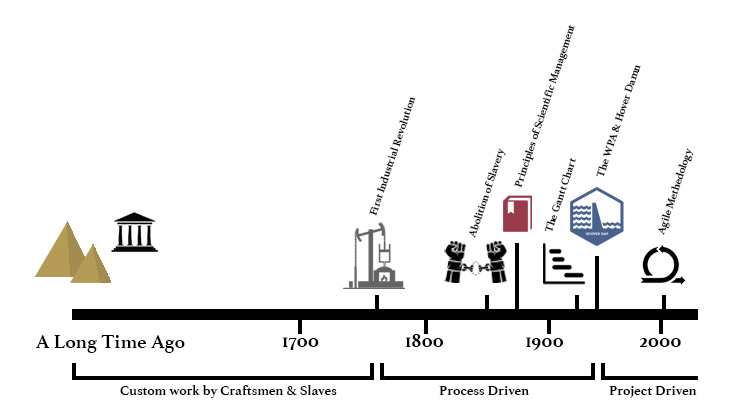Stop for a moment and answer the question, “How does work get done?”. Since the beginning of written history until the end of the 18th century, the answer was that work has been done by skilled craftsmen or by slave labor. Middle and lower class fathers taught their sons a trade such as farming or masonry, while upper class families employed slave labor to work in their fields and to work in their businesses. Don’t get me wrong, there were many other professions as well of course, such as politicians, soldiers, merchants, etc. but these did things for a living rather than creating things for a living. In this article let’s take a quick look at the history of project management and where it came from.
Early History
Prior to the 17th century, large scale concentrations of human effort focusing on common goals were funded and ordained by government and religious organizations. Think of the pyramids which were tombs for political leaders. Or consider the greek Parthenon which was a temple to the goddess Athena. Even these shining examples of human creativity though were built by slave labor and craftsmen.
1700’s
In the 17th century things began to change with the emergence of the first industrial revolution. The idea of manufacturing large quantities of goods without the need for traditional craftsmen drove industry to new heights in Europe and America. Specifically, this allowed slaves and lower class workers to produce quality items quicker and with less training than a craftsmen could.
1800’s
In the mid 1800’s, both Europe and America abolished slavery, throwing there respective economies into an unexpected workforce crisis. Things suddenly had to change, former slaves now had to be compensated and could no longer be forced to work for a specific company as before. Owners could no longer demand things of their slaves. The role of the manager became paramount.
In the late 1800’s, Fredrich Taylor started a consulting firm in Philadelphia to help organizations establish and improve their management of manufacturing processes. He went on to write Principles of Scientific Management. Taylor is recognized as the first scholar of modern business and pioneered such concepts as Benchmarking and Process Improvement.
1900’s
A few years later, in the early 1900’s, Henry Gantt expanded Taylor’s concepts by developing the quintessential tool of traditional project management. The Gantt Chart. The goal was to create a visual benchmark of expectations for manufacturing processes. This tool was adopted in 1917 by the military to help ramp up production for the creation of munitions and deployment of men for World War I. After the war, this new way of tracking processes spread to other parts of the government and into large businesses.
It wasn’t until the great depression that the modern form of project management emerged though. Just prior to 1930 America was in the middle of the second industrial revolution and everyone’s efforts were focused on making long lived manufacturing processes more productive. When the Great Depression hit America in 1929 companies went out of business left and right and demand for large quantities of merchandise simply disappeared. In 1935 Franklin D. Roosevelt started the Works Progress Administration (WPA) to put people back to work in hopes of jump starting the economy. This administrative body commissioned major, one time projects such as the Hoover Dam and Laguardia Airport. To accomplish such large scale objectives they turned to Gantt’s visual representation of work. The Gantt Chart. This marked the turning point in history for project management thinking, and shifted the conversation from improving long lived manufacturing processes to establishing a process for complex one time projects.
When World War II broke out in 1939, many of the most skilled workers were needed overseas. This left women and less skilled workers behind to play the role of employee. The new discipline of Project Management proved a formidable tool in the arsenal of businesses who now needed to manage less experienced staff with precision and predictability. This solidified the importance of project management as a discipline and by the end of the war in 1945 this new method for organizing and managing work had become mainstream.
As the thought leaders and practitioners of the day continued to improve on the foundation Tyler and Gantt established, it became clear that standardization was needed for benchmarking the benchmarkers (Haha, see what I did there?). Throughout the 1950’s and 60’s several organizations emerged to handle this issue, but in 1969 the most enduring one was established. It was named the Project Management Institute (PMI). They would go on to establish the de facto standards for the profession with over one million active members today.
Since 1969, PMI and other thought leaders have worked hard to codify the tools of the trade. These tools and practices have become known as “Waterfall Project Management”. Since 1969 several modifications to this standard have been popularized, examples include:
- Rational Unified Process (RUP)
- Critical Path Method (CPM)
- Critical Chain (CCPM)
- Lean Project Management
- Prince2
- Sashimi
2000’s
In the early 2000’s however, a competing theory to the philosophies supporting Waterfall emerged. Established by a group of technology leaders based on what they were seeing in their own development firms, the Agile Methodology was defined and written down as a simple four line manifesto with twelve supporting principles.
In contrast to the complexities and top down governance of the Waterfall methodology, this new concept focused on bottom up management and team autonomy. These thoughts go head to head with the thinking of the last 100 years, but seem to have struck a chord with technology professionals.
The Agile Methodology has been turned into several full blown project management frameworks that focus on the operations of the team as the main unit of production. The most popular include:
More recently, as digital transformation has become a requirement for nearly every organization, large corporations have started looking to more robust frameworks build on Agile principles. These frameworks focus on handling the complexities of massive, hierarchical organizations. Examples include:
- Scaled Agile (SAFe)
- Spotify
- Disciplined Agile Delivery (DaD)
- Large Scale Scrum (LeSS)
- Nexus
- XSCALE
Summary
Historically we used craftsmen and slaves to produce goods. A few centuries ago we turned to the invention of equipment and processes to change the way work was done. During World War II the western mindset shifted from process to project and launched a flurry of activity around managing this new type of work. For the last 50 years, millions of people across the globe have worked with and adapted our collective understanding of work, trying to find the most efficient way to create things.
It is interesting to note that all of the complexity around managing a project has scaled proportionally to the complexities of projects. At the turn of the 20th century the most complex thing we built was a factory. Today we are building things such as autonomous aircraft and algorithms that control international distribution systems. Additionally the way people expect to work has changed. In 1900 the corporation owned the knowledge and equipment needed to produce goods. Today that concept has been flipped on its head, with the internet providing the vast majority of knowledge and training, and our personal computers holding a thousand times more potential for production than an entire factory full of equipment. Back then, the employees needed the company, but today the company needs employees. This leaves knowledge workers in a unique spot to determine the type of project management they want to work under in the future.







Leave A Comment